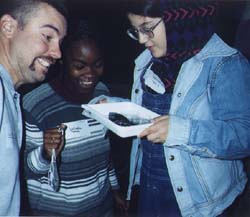 Stream
Quality
Stream
Quality
After
students went through the classroom experience of Handland and
Sandland, it is time to take them to see an actual stream environment.
We will consider what we mean when we say stream or water quality.
It is important to understand that stream quality like streams
themselves is a dynamic flowing reality--it is constantly changing
over time. A stream that is crystal clear and filled with a diverse
world of benthic organisms or creatures that live on the bottom,
could become a raging torrent, filled with mud and run-off from
the upper watershed during a storm. Anything that might live in
the stream or on its bottom is likely to be washed downstream
after a storm like this. It is important to realize that urban
streams can also feel the affects of a variety of sewer overflows
after a storm, when the water may look fine once sediments settle,
but water quality may be biologically unsafe.
Background
Water is rarely 100% clean or 100% dirty. How do
we know a stream is healthy? This module provides some activities,
information and a field book that will help students understand
the dynamic nature of streams, and give them a sense of stream
quality through the use of various tools and observations. Students
learn about small aquatic creatures called benthic organisms.
They will also learn basic water-chemistry, the use of color for
camouflage-in nature and various human impacts on stream environments.
Each student will use a field book to record his/her observations.
Teachers are encouraged to give them an opportunity to compare
and contrast different streams, or maybe just different parts
of the same stream. Look for changes in the banks, channel and
surrounding environment to give students a full experience. Remember
stream quality changes in time. By using different tools, disciplines
and skills we discover that streams are not just streams, but
complex and interesting systems.
Target
Grade Level
Grade 5-7
| Objectives |
| Students
will: |
Observe
different benthic organisms
|
Use
the presence of aquatic organisms to assess water quality
|
Use
the chemical testing as another means of assessing water
quality
|
Observe
and analyze the stream and its environment
|
Be
exposed to the impact of human activities on water quality
|
| |
|
| PA
Educational Standards |
| Related
PA Proposed Environment and Ecology Standards: Grade 7 |
|
| Streams |
- Explain
the effects of water on the life of organisms in a watershed.
|
- Explain
how the physical components of aquatic systems influence
the organisms that live there in term of size, shape,
and physical adaptations.
|
- Describe
the life cycle of organisms that depend on water.
|
- Identify
organisms that have aquatic stages of life and describe
those stages.
|
- Identify
environmental health issues.
|
|
| Environmental
Health |
- Identify
environmental health issues.
|
- Identify
various examples of long-term pollution and explain their
effects on environmental health.
|
-
Identify diseases that have been associated with poor
environmental quality.
|
|
| Ecosystem
and their Interactions |
-
Explain the flows of energy and matter from organism to
organism within an ecosystem.
|
- Identify
and explain the characteristics of biotic and abiotic
|
-
Describe and explain the adaptations of plants and animals
to their environment.
|
-
Demonstrate the dependency of living components in the
ecosystem on the nonliving components
|
- Explain
how human activities affect local, regional and national
environments.
|
- Describe
what effect consumption and related generation of wastes
have on the environment.
|
| |
| Humans
and Environment |
Explain
how human activities affect local, regional and national
environments.
|
Explain
how a particular human activity has changed the local
area over the years.
|
|
| Academic
Standards for the Arts and Humanities |
Compare
similarities in process, techniques and content in the
arts and other subject
|
Estimated
Duration
1 to 1.5-hours for the activity, and each extension
Note
to the instructor:
Students have already discussed
a local watershed in class. When you plan a field trip, choose
a place in your local watershed. Prepare safety issues and
concerns for your students. (Field
book ) |
![]()

 Stream
Quality
Stream
Quality